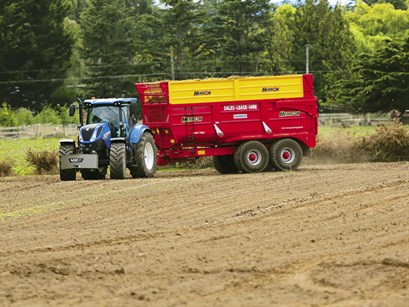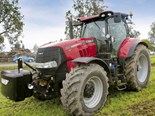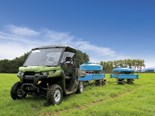TTSO 2017: John Deere 6175R
.jpg)
.jpg)












.jpg)
|

|

|

|

|

|

|
The second best CVT tractor tested by the Farm Trader judges in our Top Tractor Shoot Out this year
Technologically advanced modern farm machinery and ease of operation are two phrases that rarely appear in the same sentence. However, as part of my Top Tractor Shoot Out trip to New Zealand to drive a John Deere 6175R along with seven other tractors with CVT transmissions, I discovered that the 175hp John Deere representative was a perfect combination of cutting edge modern technology bundled into any easy-to-operate package.
The big green, powerful looking machine is a blend of technology and simplicity that virtually anyone with a bit of machinery nous can quickly master.
Operating the driving functions is intuitive, which removes the anxiety often encountered when jumping into the cabin of an unfamiliar tractor, especially for the older generation and less tech-savvy farmers and contractors.
Another podium finish
It came as no surprise that when we lined the John Deere 6175R up against the seven other entrants (Deutz-Fahr 6165 TTV, New Holland T7.225, Case IH Puma 240 CVT, Kubota M7171 KVT, Massey Ferguson 7720 DVT, Fendt 716, and the Claas Axion 930), at this year's Farm Trader Top Tractor Shoot Out competition, it was sitting on the top of the table with a total score of 328.
This represented a 13-point lead over its nearest opponent: the Claas 930 Axion. Having scored more points than its rivals across the board, it was judged the best tractor in the competition. The right to claim top billing was supported by all four judges, who agreed it was indeed the best tractor in the competition.
Unfortunately for John Deere, when its purchase price of $215,800 was factored into the equation to find Farm Trader's best value-for-money CVT tractor, the 6175R was relegated to second place in the race; the mathematical equation used to find the value-for-money winner saw it knocked down to the runner-up position despite such an impressive showing.
The 6175R received a maximum score of 10 points and supremacy over its opposition in the following areas: cabin layout, armrest controls, lighting package, mirrors, service intervals, transmission functionality and usability, hydraulic functionality, front suspension, and field performance.
The walkaround
The 6175R is manufactured in John Deere's assembly plant in Mannheim, Germany. The engine produces 175hp with a 40hp Intelligent Power Management (IPM) boost. Boost kicks in for either the PTO or transport application, PTO more than 2.5km/h and transport more than 15km/h.
As a matter of interest, we had Edwin Wiegersma of Diesel Performance Solutions (DPS) whack it on the Dyno to compare results against those promoted in the brochure. DPS is an independent remapping specialist that has no affiliation with any tractor manufacturer. After hooking the 6175R via the PTO, Edwin came up with the figures of 147hp and 188hp with boost, as opposed to the promoted figures of 175hp and 215hp respectively. DPS testing also revealed that maximum fuel usage in standard and boost modes was 34.7 litres/hour and 40.1 litres/hour respectively.

Forming the structural base is the renowned John Deere full frame chassis design. This chassis runs the full length of the machine. The rear hitch, front hitch, axles, and the optional loader attach directly onto this, and subsequently, this chassis takes up all the stresses and strains of the day-to-day operation, leaving the engine and transmission, which are cradled within it, free from those stresses and strains.
The six-cylinder, 6.8-litre, twin turbo engine runs the DPF, DOC, and SCR systems, which is claimed to reduce AdBlue consumption and increase fuel efficiency. The service intervals on the John Deere Power Systems engine is set at 750 hours on the condition that genuine John Deere Plus 50 II engine oil is used. The hydraulic oil service interval is set at 1500 hours to coincide with every second engine service.
The engine oil dipstick and fill point are within easy reach for daily inspection but the air cleaner unit is mounted high on top of the engine and is much harder to access compared to a front mounted air cleaner. In saying that, the system does have a pre-cleaner filter, which greatly extends the time between servicing unless it's operating in extremely dusty conditions. The bonnet has to be moulded higher to accommodate the top mounted air cleaner, which reduces visibility to some degree.
Forward of the engine is a fixed mounted radiator package with slide out cleaning screens. There are two schools of thought on the pros and cons of fixed versus foldout radiators. Some say foldouts are easier to clean while others claim fixed radiators resist damage caused by vibration at the hinge points. I'll let you be the judge of that.
Transmission
The John Deere Infinitely Variable Transmission (AutoPowr/IVT) utilises a combination of mechanical and hydrostatic power, providing stepless, and continuous power across an infinitely variable range of speeds. The ZF AutoPower transmission is, in my opinion, the easiest to operate out of all the tractors in its class with CVT transmissions.
A power zero capability within the transmission allows the tractor to remain perfectly still on steep hill when drive is stopped to the transmission.
One lever with two distinct stages controls the speed. Each stage can have a preprogrammed maximum speed allocated and the lever has a roller wheel for making adjustments – on the go or stationary – to this preprogrammed set speed. The speed range is infinitely variable between 50 metres/h
and 50km/h.
To get the most out of the IVT transmission, it is suggested to move the hand throttle to full revs and then move the speed lever forward until the desired speed is achieved. Once the speed is reached, the engine will only rev as hard as is required to maintain that ground speed.
Performance
Self-adjusting front fenders help achieve a good outside turning circle of 12.8 metres, enhancing its performance during loader work as well as headland turning for cropping and cultivation activities.
The front axle on the 6175R is fitted with front suspension, which John Deere refers to as triple link suspension. It is self-levelling, the benefits of which are obvious, and has two hydraulic rams either side, each with 100mm of travel for greater strength and stability. It could be assumed that dual rams improve the balance and durability of the front suspension mechanism. It is proven that front suspension improves the level of contact to the ground and getting maximum power to the ground. The suspension has three settings: Full Auto, Maximum, and Manual.
Full Auto is recommended for a majority of applications, Maximum firms it right up for the likes of loader work to reduce surging and dipping of the front end, and finally, the Manual mode allows you to raise and lower the front end, which is especially handy while attaching front hitch implements.
By lifting the front right up on the suspension, we were able to lower the rear draw bar slightly to help hitch up the 3.5-metre wide Sumo Trio cultivator we used to test out the 6175R's ability to pull a heavy load.
I'll let you know how that went when I touch on performance.

Our test tractor had six sets of double acting hydraulic front and rear remotes, available with electronic fender mounted up and down controls as well as power beyond connections and release assist levers to help with coupling and uncoupling of hydraulic hoses. The optional high flow pump delivers 155 litres/min oil flow to the hydraulic system.
Integrated into the front of the tractor is a 1000rpm PTO to complement the three-speed, 540/1000/1000E PTO at the rear. Both are electro-hydraulically operated and the rear has exterior fender mounted controllers. The 6175R can also be configured with the 540/540E/1000rpm rear PTO option.
The Cat III front hitch assembly has a four-tonne lift capacity at the hook ends and is fully integrated with the hydraulic joystick inside the cabin for ease of operation. The rear Cat III linkage has an 8.5 maximum lift at the hooks with rear fender controllers that operate at 10% of normal speed for safety reasons.
The linkage and PTO is fully integrated and built using John Deere componentry.
If there is no weight block or implement on the front, the linkage arms can be locked in the up position and out of the way using a couple of pins. This job can be done without the use of any tools and the pins stow on the linkage frame ready for use at any time.
An easily accessed positive battery terminal that eliminates the risk of computer damage during jump starting is mounted at ground level on the right-hand side of the tractor.
In the cab
The 6175R also got top billing for the quality and capability of its external John Deere wide-angle rear-view mirrors. They are fully electronic, heated, and mounted on a telescopic arm. Operation of the mirrors is done through the control centre monitor, and from the driver's seat, they provide an exceptional level of vision. It's full premium LED light package with step and fender illumination as well as time delay shut off also scored better than any other.
The key feature inside the cabin is good visibility, thanks to the large panoramic windows all around. Front and rear roller blinds, lots of storage, fully adjustable steering wheel, and a fully adjustable air suspension seat with 30-degree swivel means the operator can customise the environment to best suit their style of driving. The main controls and monitor are mounted on the seat's armrest and thus stay close at hand and within the driver's eye line wherever the seat is positioned.
A premium integrated Bluetooth radio system, climate control, and extra power sources round out the stylish, well-appointed cabin design.
The touchscreen monitor is on the small side but a larger monitor is available for an extra $1400 (approx.). Anything on the tractor that has electronic control can be operated, adjusted, stored, and saved on this monitor.
Test results
The equipment we used to establish working performance was a 3.5-metre Sumo Trio. It consisted of one row of cultivation discs followed by deep ripping tines, two rows of speed tilling disc, which was then trailed by a heavy-duty reconsolidating roller.
Suffice to say, it took a substantial amount of power and traction to run it. The idea was to push the tractors to the limit to establish the more capable machines, and pleasingly, the John Deere representative did itself proud. Reaching speeds of up to about 12km/h, it was the second-best performer only trailing the 350hp Claas, as would be expected, but surpassing some of the higher horsepower opposition.
A fully loaded silage wagon, weighing around 21 tonne, also succumbed to its leadership proving it was more than capable of heavy haulage both in the paddock and on the road at speeds up to around 38km/h during our paddock trial. In this trial, it ranked third behind the much higher-powered Claas and the Case IH entrant that had the added feature of engine braking.
Verdict
Driving the 6175R is an absolute pleasure in every regard. From the moment I got behind the wheel, I felt comfortable, confident, and ready to get to work. I believe the 6175R is an outstanding piece of equipment designed for medium to large agricultural operations and contractors, and I would confidently recommend it for consideration.
Top features
- Cabin layout
- Armrest controls
- Lighting package
- Mirrors
- Service intervals
- Transmission functionality and usability
- Hydraulic functionality
- Front suspension
- Field performance
Keep up to date in the industry by signing up to Farm Trader's free newsletter or liking us on Facebook














